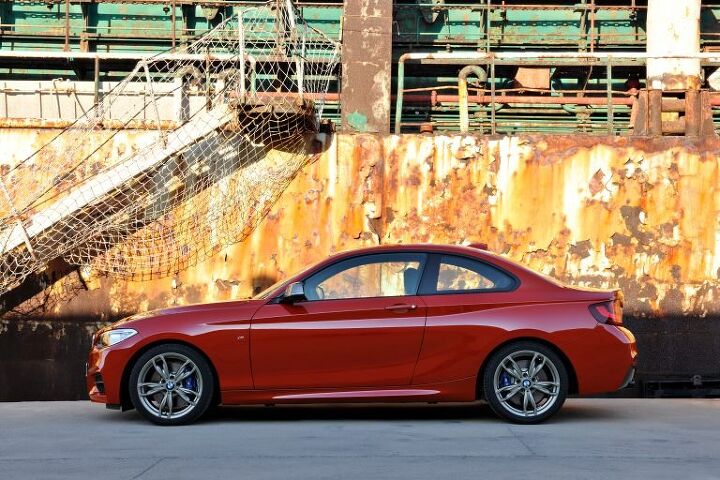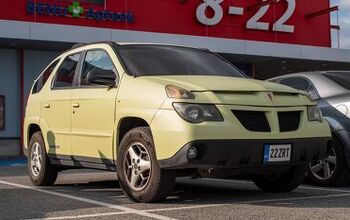While BMW USA Sales Fade, the Most and Least BMW-like Models Are Bright Spots
Forget last year’s record sales achievements in BMW USA’s showrooms. Through the first six months of 2016, sales at the BMW Group’s BMW brand are down 9 percent in the United States, a first-half pace which suggests BMW sales will fall to a three-year low even as the overall new vehicle market continues to grow.
Not only is BMW’s car division off last year’s pace by more than 20,000 sales, or 18 percent, the brand’s three most costly utility vehicles — X4, X5, X6 — are down 22 percent. Yes, the overall car market is fading, but BMW’s 22-percent car decline is far worse than the U.S. auto industry’s 8-percent drop in car sales. And the 24-percent decrease in, for instance, sales of the BMW X5 stands in stark contrast to the 8-percent increase in the overall SUV/crossover market.
There are nevertheless bright lights in the BMW lineup.
Among passenger cars, the one car that most clearly exemplifies BMW’s old Ultimate Driving Machine credo, the 2 Series, is the BMW car that’s growing fastest. By far.
Among crossovers, the BMW which most flies in the face of everything the BMW cognoscenti value about BMW, the X1, is the BMW SAV division’s fastest-growing vehicle. By far.
ENTRY-LEVEL JOBS
The 2 Series’ success comes as the majority of BMW’s vast car lineup fades. Aside from the newly launched sixth-generation 7 Series (up 7 percent to 5,605 units year-to-date), the 2 Series is the exception to the declining car rule in BMW’s showrooms. 3, 4, 5, 6, i3, i8, and Z4 volume is collectively down 24 percent, a significant loss worth 24,163 sales.
The 2 Series, however, is on pace for 22,000 sales in 2016 thanks to a 70-percent year-over-year increase through six months. The 2 Series and its 1 Series predecessor averaged 10,000 sales between 2008 and 2015 and peaked just north of 13,000 sales in 2010.
These aren’t inconsequential numbers. The 2 Series is now outselling the Scion FR-S, Subaru BRZ, and Nissan 370Z combined; outsold the Volkswagen Golf GTI and Golf R combined in June; and easily outperformed the combined best efforts of the Alfa Romeo 4C, Audi TT, BMW Z4, Mercedes-Benz SLK, and Porsche Boxster/Cayman in the first-half of 2016.
Is the 2 Series the new 3 Series? Not quite. Though total 3 Series/4 Series volume is down 23 percent this year, the 2 Series’ bigger brethren are still outselling the 2 Series by nearly six-to-one. But the 2 Series is the rightful successor to the 3 Series of the ’80s and ’90s. While demand for more costly BMW cars fade, demand for this most BMW-esque of current BMWs is at an all-time high.
MARKS THE SPOT
A front-wheel-drive BMW isn’t half as heretical to the typical X1 consumer as it is to the BMW aficionado who memorized the gear ratios of the E30 318i. Remember the story in 2010 that said the overwhelming majority of 1 Series owners didn’t know their car was driven from the rear? It seems highly unlikely that those buyers will care about the origins of their vehicle’s architecture, particularly when the overwhelming majority of X1 buyers opt for four driven wheels.
Compared with the first-half of 2015, X1 sales in 2016 have more than doubled to 12,139 units. Although the X4, X5, and X6 are all failing to match last year’s volume, the X1 isn’t alone in its BMW SAV gains. The BMW X3 has produce a substantial 49-percent gain and is likely to end the year with its highest-ever U.S. sales output.
DIFFERENT STROKES
Outside of these two models, BMW USA lost 25,000 sales in the first-half of 2016.
The 2 Series and X1, the most BMW-like and least BMW-like models in the BMW brand’s lineup and the two BMWs with the lowest base prices, added 10,000 sales.
[Images: BMW USA]
Timothy Cain is the founder of GoodCarBadCar.net, which obsesses over the free and frequent publication of U.S. and Canadian auto sales figures. Follow on Twitter @goodcarbadcar and on Facebook.
More by Timothy Cain
Latest Car Reviews
Read moreLatest Product Reviews
Read moreRecent Comments
- Analoggrotto Does anyone seriously listen to this?
- Thomas Same here....but keep in mind that EVs are already much more efficient than ICE vehicles. They need to catch up in all the other areas you mentioned.
- Analoggrotto It's great to see TTAC kicking up the best for their #1 corporate sponsor. Keep up the good work guys.
- John66ny Title about self driving cars, linked podcast about headlight restoration. Some relationship?
- Jeff JMII--If I did not get my Maverick my next choice was a Santa Cruz. They are different but then they are both compact pickups the only real compact pickups on the market. I am glad to hear that the Santa Cruz will have knobs and buttons on it for 2025 it would be good if they offered a hybrid as well. When I looked at both trucks it was less about brand loyalty and more about price, size, and features. I have owned 2 gm made trucks in the past and liked both but gm does not make a true compact truck and neither does Ram, Toyota, or Nissan. The Maverick was the only Ford product that I wanted. If I wanted a larger truck I would have kept either my 99 S-10 extended cab with a 2.2 I-4 5 speed or my 08 Isuzu I-370 4 x 4 with the 3.7 I-5, tow package, heated leather seats, and other niceties and it road like a luxury vehicle. I believe the demand is there for other manufacturers to make compact pickups. The proposed hybrid Toyota Stout would be a great truck. Subaru has experience making small trucks and they could make a very competitive compact truck and Subaru has a great all wheel drive system. Chevy has a great compact pickup offered in South America called the Montana which gm could make in North America and offered in the US and Canada. Ram has a great little compact truck offered in South America as well. Compact trucks are a great vehicle for those who want an open bed for hauling but what a smaller more affordable efficient practical vehicle.



































Comments
Join the conversation
You could have just said: "BMW unit sales continue to collapse even as it pushed more of its lowest priced, lowest profit margin vehicles out the door. Many people who like to spend too much money on their fashion/image statement automotive purchases have moved on to other objects of envy." A great editor once told me: "Fewer words, more insight."
I think many of those who traditionally steered friends and relatives to BMW as well as magazine writers no longer do that. I owned 6 BMWs from M3 to 535 wagon and still own 2 but frankly no longer interested that much. They have grown in size, electric steering is very non-BMW, their cars just don't feel like true BMW anymore. Not Lexus just yet, but pretty undistinguishable from MB or Audi. Hey, my wife who NEVER liked BMW actually likes X3 now...